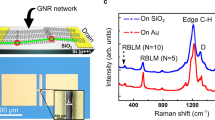Abstract
By performing first-principles transport simulations, we demonstrate that n-type transfer curves can be obtained in armchair-edged graphene nanoribbon field effect transistors by the potassium atom and cobaltocene molecule doping, or substituting the carbon by nitrogen atom. The Dirac point shifts downward from 0 to −12 V when the n-type impurity concentration increases from 0 to 1.37%, while the transfer curves basically maintain symmetric feature with respect to the Dirac point. In general, the on/off current ratios are decreased and subthreshold swings are increased with the increasing doping level. Therefore, the performance of armchair-edged graphene nanoribbon field effect transistors can be controlled via tuning the impurity doping level.






Similar content being viewed by others
References
Stankovich S, Dikin DA, Dommett GHB, Kohlhaas KM, Zimney EJ, Stach EA, Piner RD, Nguyen ST, Ruoff RS (2006) Graphene-based composite materials. Nature 442(7100):282–286
Geim AK, Novoselov KS (2007) The rise of graphene. Nat Mater 6(3):183–191
Novoselov KS, Geim AK, Morozov SV, Jiang D, Zhang Y, Dubonos SV, Grigorieva IV, Firsov AA (2004) Electric field effect in atomically thin carbon films. Science 306(5696):666–669
Novoselov KS, Jiang D, Schedin F, Booth TJ, Khotkevich VV, Morozov SV, Geim AK (2005) Two-dimensional atomic crystals. Proc Natl Acad Sci USA 102(30):10451–10453
Son Y-W, Cohen ML, Louie SG (2006) Energy Gaps in Graphene Nanoribbons. Phys Rev Lett 97(21):216803
Son YW, Cohen ML, Louie SG (2006) Half-metallic graphene nanoribbons. Nature 444(7117):347–349
Barone V, Hod O, Scuseria GE (2006) Electronic structure and stability of semiconducting graphene nanoribbons. Nano Lett 6(12):2748–2754
Han MY, Ozyilmaz B, Zhang YB, Kim P (2007) Energy band-gap engineering of graphene nanoribbons. Phys Rev Lett 98(20):206805
Yan QM, Huang B, Yu J, Zheng FW, Zang J, Wu J, Gu BL, Liu F, Duan WH (2007) Intrinsic current-voltage characteristics of graphene nanoribbon transistors and effect of edge doping. Nano Lett 7(6):1469–1473
Schedin F, Geim AK, Morozov SV, Hill EW, Blake P, Katsnelson MI, Novoselov KS (2007) Detection of individual gas molecules adsorbed on graphene. Nat Mater 6(9):652–655
Li XL, Wang XR, Zhang L, Lee SW, Dai HJ (2008) Chemically derived, ultrasmooth graphene nanoribbon semiconductors. Science 319(5867):1229–1232
Wang XR, Li XL, Zhang L, Yoon Y, Weber PK, Wang HL, Guo J, Dai HJ (2009) N-Doping of Graphene Through Electrothermal Reactions with Ammonia. Science 324(5928):768–771
Wang ZF, Li QX, Shi QW, Wang XP, Hou JG, Zheng HX, Chen J (2008) Ballistic rectification in a Z-shaped graphene nanoribbon junction. Appl Phys Lett 92(13):3
Soler JM, Artacho E, Gale JD, Garcia A, Junquera J, Ordejon P, Sanchez-Portal D (2002) The SIESTA method for ab initio order-N materials simulation. J Phys: Condens Mat 14(11):2745–2779
Perdew JP, Burke K, Ernzerhof M (1996) Generalized gradient approximation made simple. Phys Rev Lett 77(18):3865–3868
Monkhorst HJ, Pack JD (1976) Special points for Brillouin-zone integrations. Phys Rev B 13(12):5188
Wang L, Cai ZX, Wang JY, Lu J, Luo GF, Lai L, Zhou J, Qin R, Gao ZX, Yu DP, Li GP, Mei WN, Sanvito S (2008) Novel One-Dimensional Organometallic Half Metals: Vanadium-Cyclopentadienyl, Vanadium-Cyclopentadienyl-Benzene, and Vanadium-Anthracene Wires. Nano Lett 8(11):3640–3644
Taylor J, Guo H, Wang J (2001) Ab initio modeling of quantum transport properties of molecular electronic devices. Phys Rev B 63(24):245407
Brandbyge M, Mozos JL, Ordejon P, Taylor J, Stokbro K (2002) Density-functional method for nonequilibrium electron transport. Phys Rev B 65(16):165401
Datta S (1995) Electronic Transport in Mesoscopic Systems. Cambridge University Press, Cambridge, England
Mulliken RS (1955) Electronic Population Analysis on Lcao-Mo Molecular Wave Functions.3. Effects of Hybridization on Overlap and Gross Ao Populations. J Chem Phys 23(12):2338–2342
Newman CR, Frisbie CD, da Silva DA, Bredas JL, Ewbank PC, Mann KR (2004) Introduction to organic thin film transistors and design of n-channel organic semiconductors. Chem Mat 16(23):4436–4451
Xia FN, Farmer DB, Lin YM, Avouris P (2010) Graphene Field-Effect Transistors with High On/Off Current Ratio and Large Transport Band Gap at Room Temperature. Nano Lett 10(2):715–718
Qi P, Javey A, Rolandi M, Wang Q, Yenilmez E, Dai H (2004) Miniature Organic Transistors with Carbon Nanotubes as Quasi-One-Dimensional Electrodes. J Am Chem Soc 126(38):11774–11775
Li Y, Zhou Z, Shen P, Chen Z (2009) Spin Gapless Semiconductor-Metal-Half-Metal Properties in Nitrogen-Doped Zigzag Graphene Nanoribbons. ACS Nano 3(7):1952–1958
Schwierz F (2010) Graphene Transistors. Nat Nanotechnol 5(7):487–496
Acknowledgments
This work was supported in Japan by the Grant-in-Aid for Scientific Research on Priority Area and Next Generation Super Computing Project (Nanoscience Program) from the MEXT of Japan, in China by the NSFC (Grant Nos. 10774003, 10474123, 10434010, 90606023, and 20731160012) and National 973 Projects (Nos. 2002CB613505 and 2007CB936200, MOST of China), and in USA by Nebraska Research Initiative and DOE DE-EE0003174.
Author information
Authors and Affiliations
Corresponding author
Additional information
Dedicated to Professor Shigeru Nagase on the occasion of his 65th birthday and published as part of the Nagase Festschrift Issue.
Electronic supplementary material
Below is the link to the electronic supplementary material.
Rights and permissions
About this article
Cite this article
Wang, L., Zheng, J., Zhou, J. et al. Tuning graphene nanoribbon field effect transistors via controlling doping level. Theor Chem Acc 130, 483–489 (2011). https://doi.org/10.1007/s00214-011-1026-5
Received:
Accepted:
Published:
Issue Date:
DOI: https://doi.org/10.1007/s00214-011-1026-5




